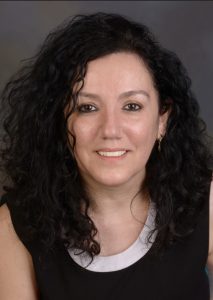Dr. Stefania Marsili, Senior Basic Scientist, Dr. David Calkins’ Lab
Vanderbilt Eye Institute, Vanderbilt University Medical Center
 The ongoing modifications of the ECM environment in both healthy and diseased states consistently expose cells to diverse stimuli, which can alter their shape and viscoelastic and biochemical properties and the re-establishment of the helical arrangement of fragmented collagen-I fibers may be beneficial in restoring the biochemical and structural functions of the extracellular matrix as well as in re-establishing homeostatic cell signaling, which is affected by inflammatory signals and oxidative stress that initiate a variety of diseases, ranging from cancer to neurodegenerative diseases. My research focused on evaluating the efficacy of Collagen Mimetic Peptides (CMPs) in repairing collagen degraded by metalloproteinases (MMPs). This new knowledge provides crucial insights into the selection of suitable CMPs molecules as therapeutic agents for the treatment of diseases that damage either structural or extracellular matrix collagens, including those affecting the visual system. Specifically, I have been interested in studying changes in the thickness, mass, and viscosity of collagen-I over small-time scales during adsorption, proteolysis by MMP-1, and treatment with CMP using a Quartz Crystal Microbalance with Dissipation Monitoring (QCM-D) platform. This platform has been effectively used to determine protein adsorption kinetics, antibody-antigen interactions, and cell attachment at a high-throughput level. The advantage of QCM-D is its high sensitivity to changes in mass per unit area (in the ng/cm2 range), ease of use, and ability to conduct real-time measurements. In addition, the ability to measure energy dissipation allows the determination of the viscosity and elasticity of the adsorbed layers. With this technology, I was also able to assess the kinetic properties of CMP binding to degraded collagen-I, which provided a starting point for assessing the distinct affinities of different CMPs for cleaved collagens and their effects on morphological, biochemical, and structural changes in the ECM. Also, by means of Atomic Force Microscopy and Scanning Electron Microscopy I was able to visualize the interaction of CMP linked to gold nanoparticles to damaged collagen. The next step will be the use of CMPs in preclinical studies using animal models for human ocular diseases to allow the assessment of the long-term efficacy and toxicity of this therapeutic treatment, thus opening an avenue for future clinical applications for the treatment of diseases, disorders, and injuries associated with damage to tissue-resident collagens.
The ongoing modifications of the ECM environment in both healthy and diseased states consistently expose cells to diverse stimuli, which can alter their shape and viscoelastic and biochemical properties and the re-establishment of the helical arrangement of fragmented collagen-I fibers may be beneficial in restoring the biochemical and structural functions of the extracellular matrix as well as in re-establishing homeostatic cell signaling, which is affected by inflammatory signals and oxidative stress that initiate a variety of diseases, ranging from cancer to neurodegenerative diseases. My research focused on evaluating the efficacy of Collagen Mimetic Peptides (CMPs) in repairing collagen degraded by metalloproteinases (MMPs). This new knowledge provides crucial insights into the selection of suitable CMPs molecules as therapeutic agents for the treatment of diseases that damage either structural or extracellular matrix collagens, including those affecting the visual system. Specifically, I have been interested in studying changes in the thickness, mass, and viscosity of collagen-I over small-time scales during adsorption, proteolysis by MMP-1, and treatment with CMP using a Quartz Crystal Microbalance with Dissipation Monitoring (QCM-D) platform. This platform has been effectively used to determine protein adsorption kinetics, antibody-antigen interactions, and cell attachment at a high-throughput level. The advantage of QCM-D is its high sensitivity to changes in mass per unit area (in the ng/cm2 range), ease of use, and ability to conduct real-time measurements. In addition, the ability to measure energy dissipation allows the determination of the viscosity and elasticity of the adsorbed layers. With this technology, I was also able to assess the kinetic properties of CMP binding to degraded collagen-I, which provided a starting point for assessing the distinct affinities of different CMPs for cleaved collagens and their effects on morphological, biochemical, and structural changes in the ECM. Also, by means of Atomic Force Microscopy and Scanning Electron Microscopy I was able to visualize the interaction of CMP linked to gold nanoparticles to damaged collagen. The next step will be the use of CMPs in preclinical studies using animal models for human ocular diseases to allow the assessment of the long-term efficacy and toxicity of this therapeutic treatment, thus opening an avenue for future clinical applications for the treatment of diseases, disorders, and injuries associated with damage to tissue-resident collagens.
Every step of my research has been heavily dependent on VINSE facilities, including the analytical laboratory and the advanced image facility, allowing research to be performed at the cutting edge of science. The most rewarding aspect of VINSE is the strong sense of community it fosters, and I am incredibly thankful to VINSE and all the wonderful VINSE staff.
Contact: stemarsi.sm@gmail.com